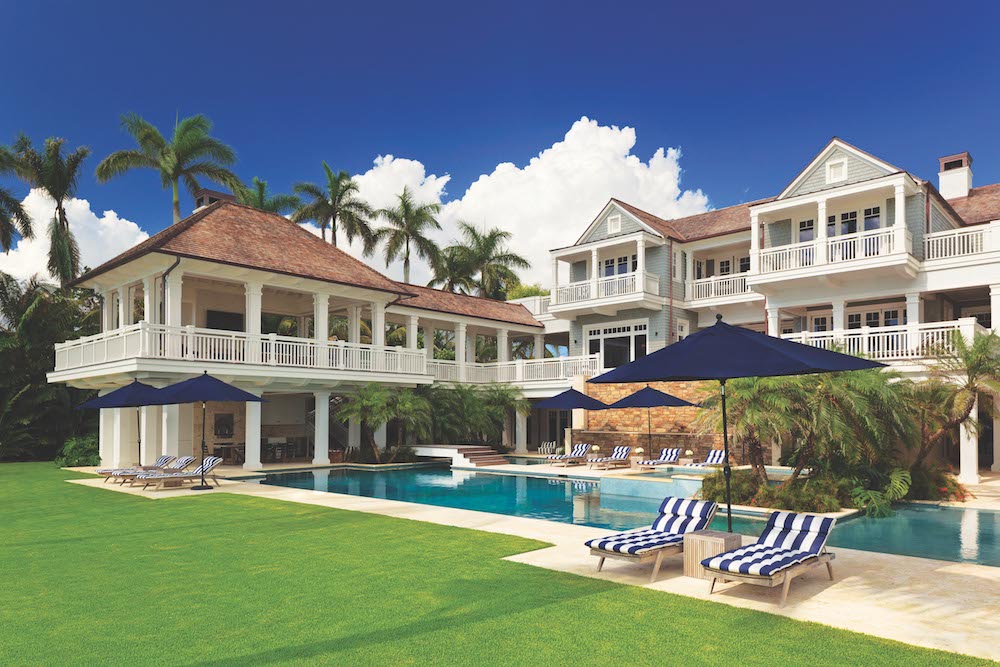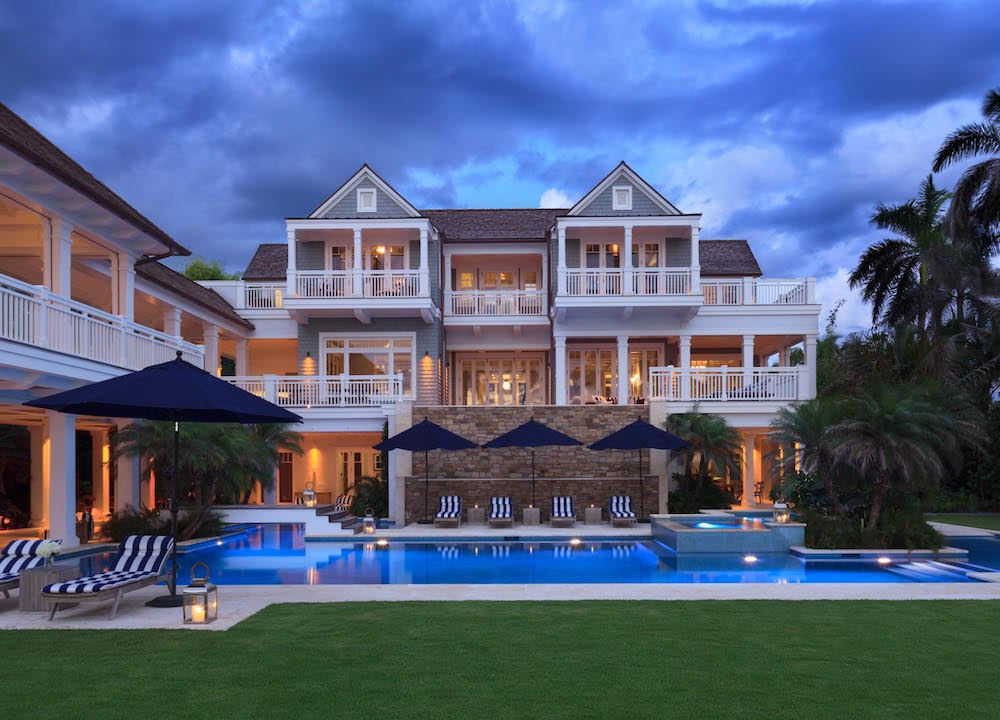1274_HDP043(1).jpg)
1274_HDP043(1).jpg)
Yet all of their years spent designing coastal homes – including more than three dozen beachfront residences in Florida alone – could not have prepared them for one northeastern family’s vision back in 2012.
There was nothing unusual in the first three requests. “They wanted an understated home, with top-quality materials that would wear well and last,” Cooney recalls, adding that the clients – who spend most of their time in New York City and western Connecticut – wanted a vacation home with a resort-like feel blended into the overall architecture.
“And we don’t want the typical Florida architecture,” the clients told him. “There are enough homes down here that look alike.”
What they wanted, however, was something the architectural firm had never done before: “They wanted Hamptons Shingle style meets Florida tropical,” says Stofft.
“They had numerous photos of home styles in The Hamptons, on Martha’s Vineyard and Nantucket,” Cooney adds, “and their specific request was: ‘We want a Hamptons-meets-Naples home.’ ”
Before they could even begin working on a way to meld the two very different architectural styles, Stofft and Cooney first had to convince the clients that they were the right team for the job.
The clients were drawn to the firm for its expertise building oceanfront homes that satisfied Florida’s strict codes for storm surge safety (more on this later), but they had reservations that Floridian architects could effectively incorporate Hamptons-style design elements.
Once the clients learned that Cooney grew up in The Hamptons and Stofft had designed Shingle-style homes on Martha’s Vineyard, they were ready to get started.
Because wood applications like cedar shake shingles don’t hold up well in Florida’s hot, humid climate, Stofft and Cooney had to reinvent how to apply those shingles to the home’s masonry frame.




They first waterproofed the masonry and then attached the shingles to a secondary wall system built along the home’s perimeter.
The shingles were then stained on all sides and affixed in such a way that air could ventilate underneath them, thereby mitigating the likelihood that they would warp, cup or bow in South Florida’s inherent humidity.
With a system in place to effectively incorporate the Hamptons-style shingled roofs, Stofft and Cooney knew they needed an equally classic aesthetic from traditional Floridian homes to complement the cedar shake shingles.
They found it by recreating a tabby stucco cladding mixed with seashells, which was once the predominant foundation material for many Floridian homes. They also used pecky cypress for the tongue-and-groove ceilings, which further connected the home to its location.
“Randy and I worked hard to introduce materials and details that brought in that tropical Naples element,” says Cooney. “It’s one of the reasons why the house turned out so well. The Hamptons look and the tropical details complement each other very well.”
“It was fun to work with old-world techniques,” adds Joe Smallwood, president and CEO of BCB Homes, the company tasked with building the sprawling estate. “We hand scraped the pecky cypress ceiling materials on site; and incorporating the tabby on the lower level of the home, and the cedar shakes on the upper levels and roof, made the project unique.”
The design was challenging in other ways. The three-acre estate is comprised of a 10,000-square-foot main house, which is situated along the Gulf of Mexico; a 4,200-square-foot guesthouse; and a 2,000-square-foot caretaker’s cottage. The latter two are located across the street on an inter-coastal waterway, making the entire estate rather unique and providing, as Cooney says, “the best of both worlds.”




But because the western coastline of Florida features very few sand dunes, homes that are built along the coast must feature a break-away first floor, which is designed to allow a storm-induced ocean swell to pass through it without destroying the entire structure.
That breakaway first floor needed to be concealed in a way that the outdoor living and pool areas at ground level felt connected to the indoor and outdoor living and entertaining areas on the floor above.
That’s where Koby Kirwin, president of Exteriors by Koby Kirwin, came in. Kirwin first focused just off the main floor’s living area, placing a placid pool with an infinity edge that spills out and cascades down a stone wall to the family pool a dozen feet below.
“The entry is intended to be dramatic,” he says, noting its unobstructed vistas of the Gulf of Mexico. “The resulting view is one of calmness and serene satisfaction,” Kirwin adds.
He also positioned the stairs that connect the upper outdoor living spaces with the main pool below on the sides of the home, so that they wouldn’t detract from the ocean views or the water features.
He then planted a variety of tropical species – coconut, fishtail and traveler’s palms, intermixed with black bamboo – to promote a lush green landscape visible from the home’s side windows, and utilized large trees and plantings around the foundation to “misdirect views of the home’s transition.
“As you walk up the entry steps to the home,” Kirwin continues, “you are walking up and through the layers of the garden.”
Although the clients had very specific demands for the home’s overall aesthetic, they gave Stofft and Cooney carte blanche to design the house and its layout as they saw fit, provided there were enough bedrooms for their five children.




The architects began by incorporating design features that have come to epitomize their Floridian homes, such as covered terraces with outdoor kitchens, sun decks with plunge pools and, most notably, an open-air outdoor pavilion – equipped with a fireplace, TV and hurricane shutters – featuring a vaulted ceiling accented by tongue-and-groove woodwork.
“It’s not typical of post-modern Shingle style architecture,” says Cooney, “but it just looks like it belongs. It works seamlessly with the design.”
Similarly, the architects adapted the Shingle style motif to accommodate large cutouts for expansive picture windows and doors, especially in the rear to maximize views of the gulf – a feature that supports Stofft’s and Cooney’s mantra to bring the outdoors in and vice versa.
The architects also had the option of selecting a spacious, open layout – a feature of many Floridian homes – or more compartmentalized rooms that often characterize coastal homes in the Northeast.
Stofft and Cooney incorporated a spacious layout but emphasized vaulted, textured ceilings to prevent the living areas from feeling too large and impersonal.


.jpg)
.jpg)
“When you design small homes, you want them to feel open and big,” Cooney says. “But when you design large homes, you have to bring a human scale to them. You want them to feel cozy and comfortable.”
The challenge of imparting a level of comfort and informality to the expansive interiors was one that New York City-based interior designer Steven Sclaroff enthusiastically embraced.
Having worked with the clients on two previous homes, he knew what they liked and had established a good rapport with them. But that introduced a separate challenge. “You don’t want to do anything that you’ve already done,” he says.
The couple wanted a home that conjured up the feeling that they had traveled somewhere, so Sclaroff incorporated pecky cypress ceilings into many rooms. “It’s a Florida cliché, but that’s part of why we wanted it,” he explains. “It’s going somewhere. You went to Florida so you get your pecky cypress.”
Traditional pecky cypress is a light color, but Sclaroff used a darker finish that provides an eye-catching contrast with his choice of white-stained oak floors. “Even though the house is pretty traditional architecturally, we gave the interiors a more modern feel by the character of the finishes and pieces and also the spare furnishings.”
Sclaroff also intertwined nautical elements – Dutch boat cleats as drawer and cabinet handles, white and blue Moroccan tiles and a stone bar top complete with fossilized fish bones, among other examples – to enhance the home’s coastal theme.
Even the red, white and blue color scheme, which characterizes most rooms, furthers the home’s coastal motif. “It’s a perfect solution for this setting,” says Sclaroff. “It’s something classic and appealing and has an inherent nautical vibe.”
Despite the success of the home, completed in March 2015 after about three years of design and construction – and the fact that Stofft Cooney is now working on two smaller Shingle style homes in Naples – Cooney doesn’t foresee this hybrid architecture becoming popular in South Florida.


“Most of our Florida clients want a maintenance-free home, but there’s no such thing,” he says. “We end up using concrete, tile roofs, stucco – all materials that require very little maintenance and just need to be cleaned and painted once in a while. But the cedar shakes at some point will have to be removed and reinstalled. Even up north, cedar shakes require maintenance.”
While Stofft and Cooney may not design many homes in this style, there’s no denying the project has set a new benchmark for Floridian architecture. In fact, they may be the only Florida architects who could have pulled it off. “It really came naturally for Randy and me to design this home,” says Cooney.
For more information, visit stofftcooney.com, bcbhomes.com, kobykirwin.com, and stevensclaroff.com.
Image Credits: Photos by Lori Hamilton Photography.


